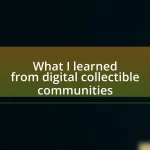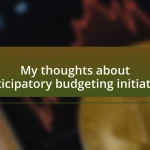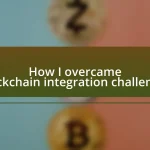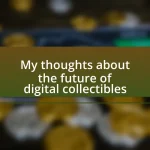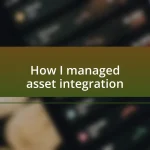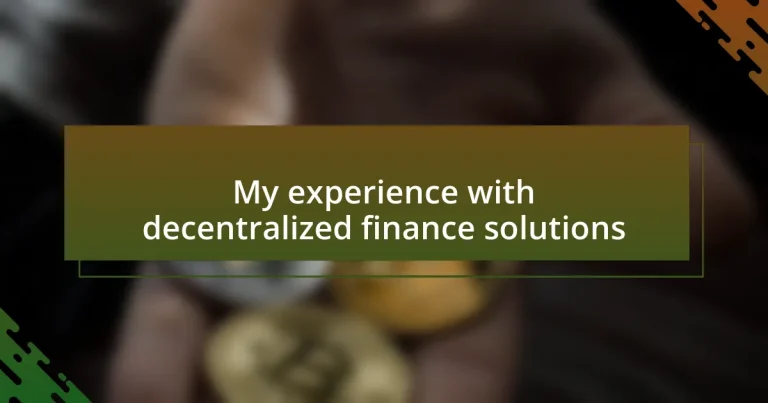Key takeaways:
- Decentralized finance (DeFi) enhances financial systems through greater accessibility, transparency, and control for users.
- Personal experiences with DeFi, such as yield farming and navigating platforms, highlight both its empowering potential and inherent risks.
- Research, diversification, and community engagement are crucial for successful participation in DeFi investments.
- The future of DeFi may involve collaboration with traditional finance and improvements in security and user experience, promoting broader adoption.
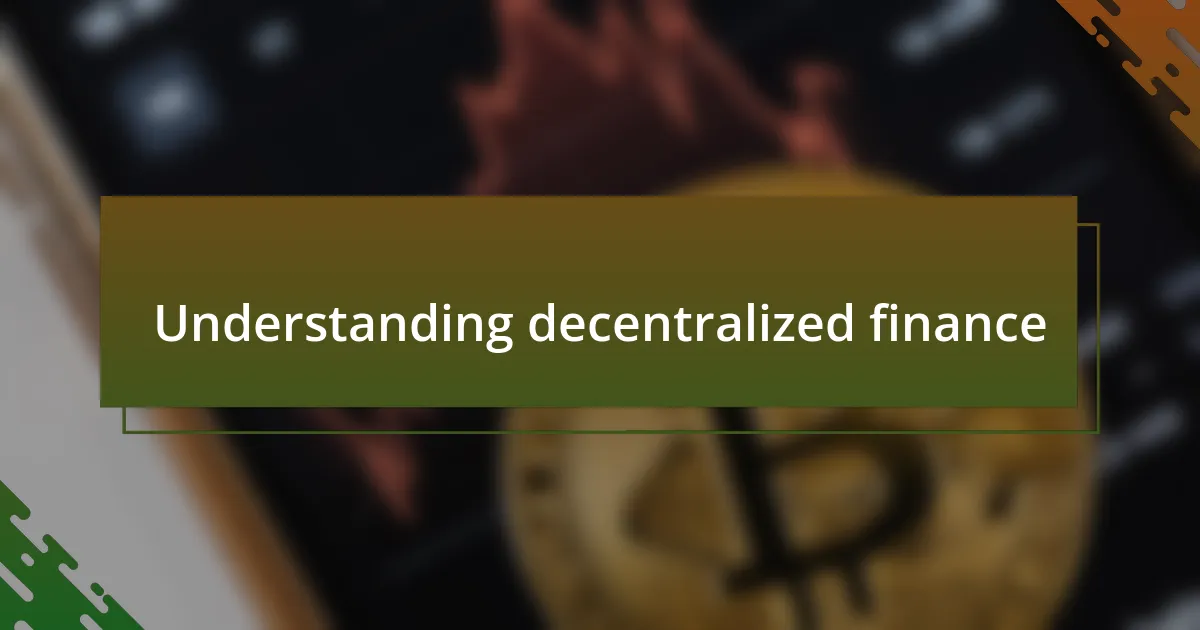
Understanding decentralized finance
Decentralized finance, or DeFi, fundamentally reshapes how we think about financial systems. When I first heard about it, I was skeptical—how could anyone trust a system that didn’t rely on traditional banks? But as I explored the mechanics behind DeFi, including smart contracts and blockchain technology, it became clear that this revolutionary approach offers transparency and accessibility like never before.
One standout moment for me was when I participated in a yield farming project for the first time. The thrill of receiving rewards while I slept was exhilarating, almost like finding a hidden treasure. This experience underscored how DeFi can empower individuals, allowing us to earn returns on our investments without needing a financial intermediary.
It’s also fascinating to consider the challenges DeFi faces, such as security risks and regulatory scrutiny. I often wonder, can decentralized systems truly achieve mainstream acceptance while navigating these hurdles? My journey in understanding DeFi has been a balance of excitement and caution, highlighting the potential benefits alongside the realities we must grapple with.
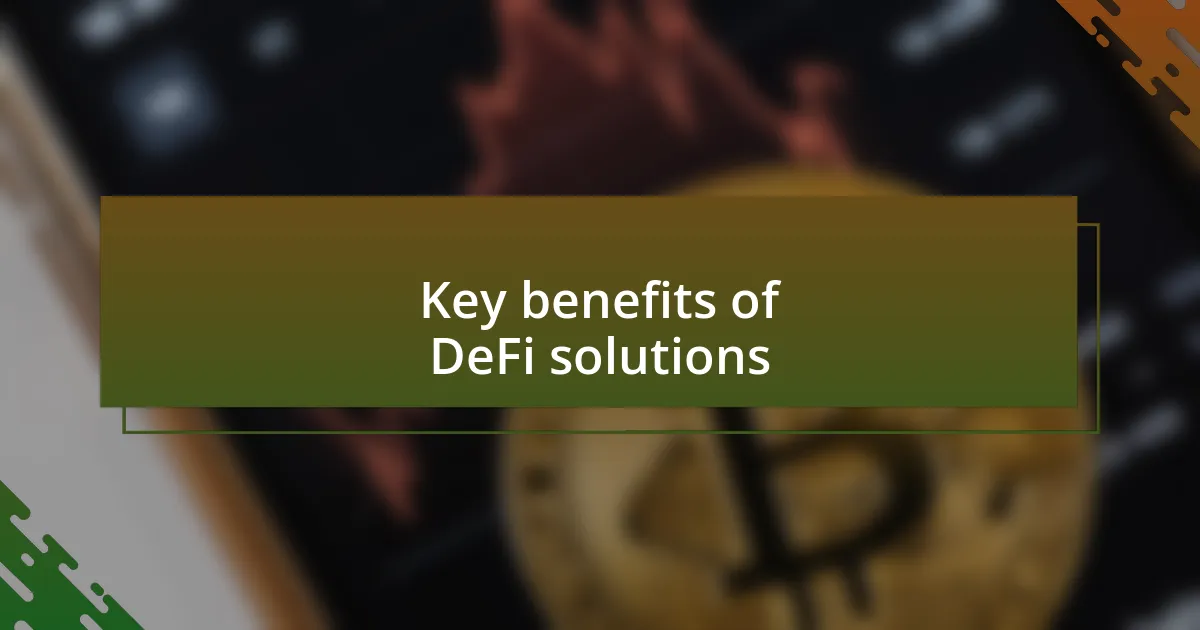
Key benefits of DeFi solutions
Decentralized finance (DeFi) solutions offer an array of significant benefits that can truly enhance our financial lives. One of the most striking advantages I’ve noticed is the increased accessibility they provide. For example, I recall a conversation I had with a friend who lives in a remote area, where traditional banking is practically non-existent. Through DeFi, he gained access to lending and investment opportunities that he otherwise couldn’t touch. This democratization of finance excites me as it brings opportunities to the masses who are often left out of the mainstream financial ecosystem.
Another key benefit of DeFi is the transparency inherent in blockchain technology. It allows all transactions to be publicly verified, which enhances trust. I remember tracking my transactions and feeling this sense of security knowing I could always verify what was happening. Here’s a list of some essential advantages of DeFi:
- Accessibility: Anyone with internet access can participate, breaking down geographical barriers.
- Transparency: Open ledgers provide real-time visibility into all transactions.
- Lower Costs: Without intermediaries, fees can be significantly reduced.
- Control: Users maintain ownership of their funds, as they don’t have to trust a bank or institution.
- Innovation: The rapid development of new financial products and services keeps the ecosystem dynamic and exciting.
These elements not only empower users but also foster a community-driven approach to finance that I find truly inspiring.
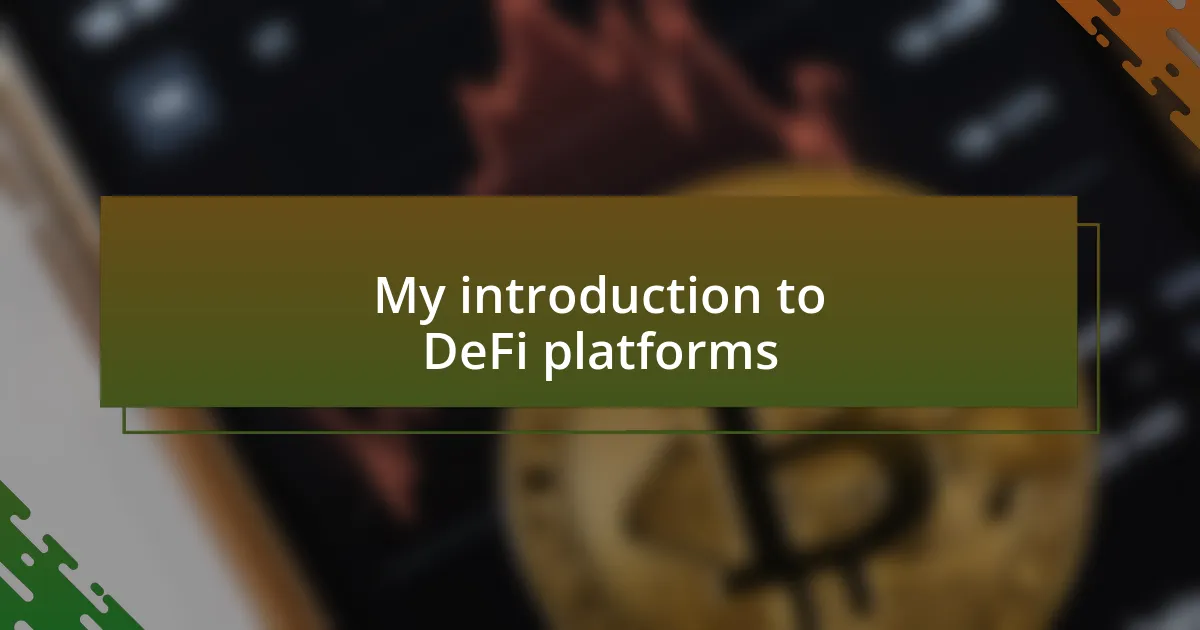
My introduction to DeFi platforms
My journey into the world of decentralized finance (DeFi) platforms began quite unexpectedly. I was initially drawn in by the buzz surrounding cryptocurrencies and the promise of a new financial landscape. One evening, while experimenting with a simple wallet app, I stumbled upon my first DeFi platform. The thrill of lending my assets and seeing them earn interest in real-time was an exhilarating moment. It felt like stepping into a new realm where I could take control of my financial destiny, something I had always longed for.
As I delved deeper into this ecosystem, I began to appreciate the diversity of options available. For instance, I vividly remember reviewing various liquidity pools and yield farming opportunities. It was a learning curve, filled with trial and error. Each success taught me the importance of research and risk management, while every setback reinforced my resolve to understand the intricacies of DeFi. This hands-on experience was not just about the potential financial gains; it was about empowerment and fostering a sense of community with like-minded individuals.
The most transformative aspect of DeFi for me has been its ability to redefine my relationship with money. The act of navigating these platforms made me realize the value of being my own banker. I have encountered both exhilarating rewards and stark challenges along the way, yet each moment has contributed to a deeper appreciation for this innovative space that holds the potential to democratize finance for everyone.
| Aspect | Details |
|---|---|
| Initial Attraction | Curiosity piqued by cryptocurrency discussions |
| First Experience | Discovering lending and earning interest |
| Learning Curve | Understanding liquidity pools and yield farming |
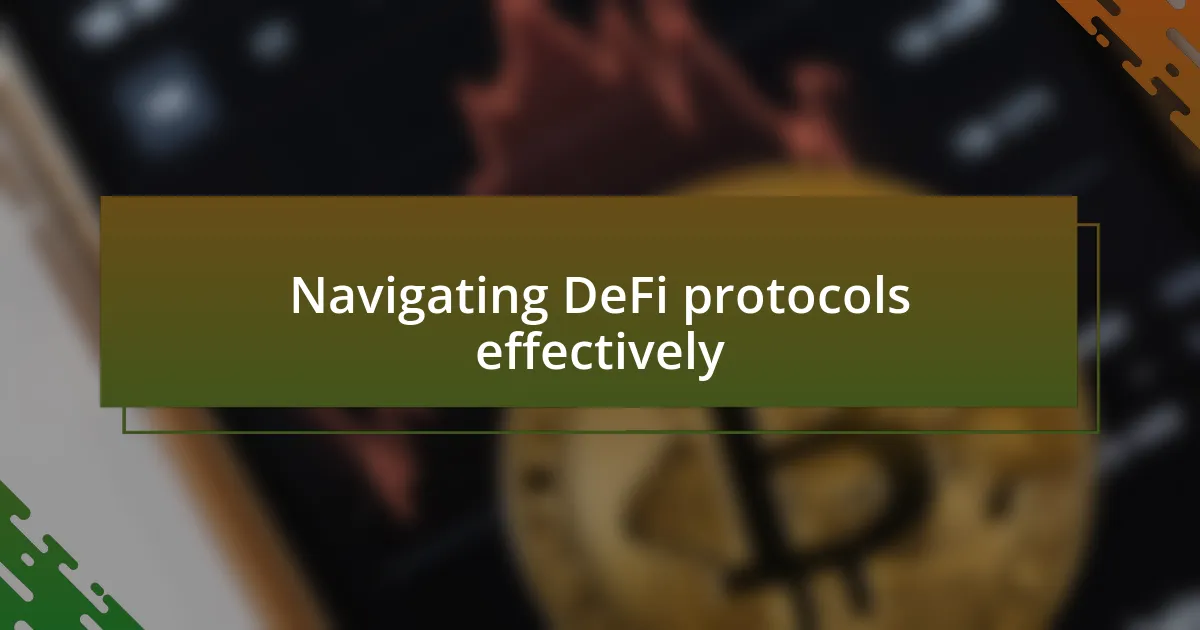
Navigating DeFi protocols effectively
Navigating DeFi protocols can feel overwhelming at first, especially with so many options available. I remember straying into unfamiliar territory when I encountered my first governance token; the idea of having a say in protocol decisions was both empowering and intimidating. It raised a question for me: how can one effectively participate in governance if they don’t fully understand the underlying mechanisms?
During my journey, the key to effective navigation became research and community engagement. I was fortunate enough to join a few discussion forums where experienced users shared invaluable insights that helped me decipher complex protocols. I often found that questioning and collaborating with others reduced the learning curve significantly. Have you ever felt lost in a sea of information? These moments of doubt pushed me to reach out more, transforming uncertainty into clarity.
I also learned the importance of using testnets to experiment without risking real assets. One of my early attempts at yield farming taught me about impermanent loss. I didn’t consider how volatile assets could affect my returns, which was a painful lesson. Now, I approach each protocol with a more analytical mindset, ensuring I explore all potential risks and rewards before diving in.
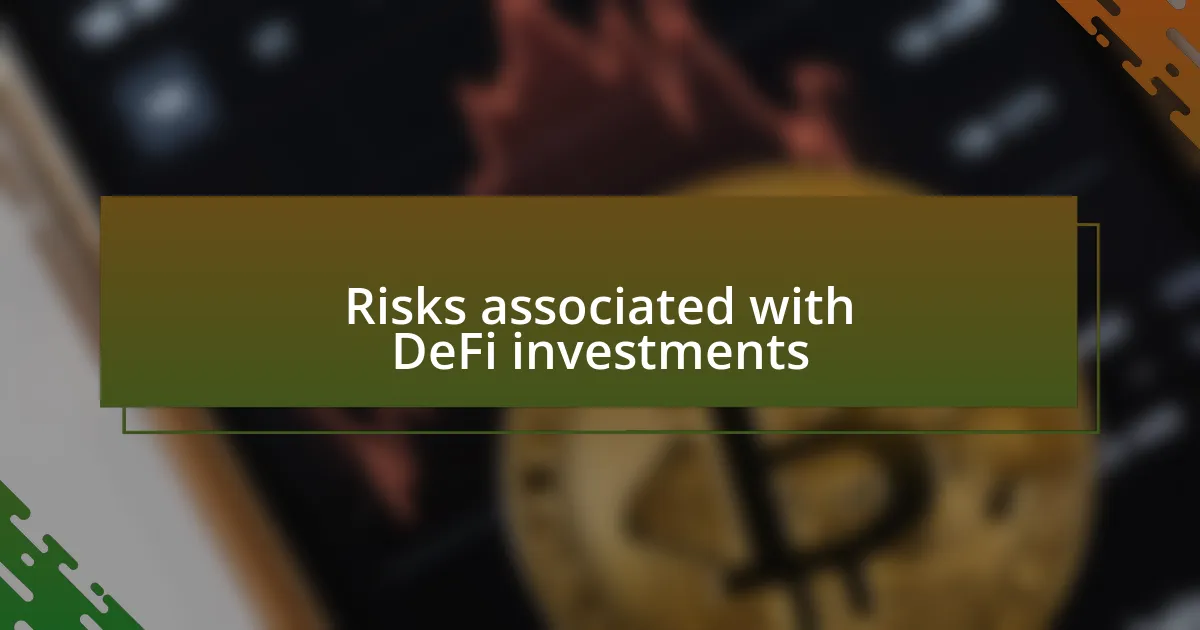
Risks associated with DeFi investments
As I dove deeper into DeFi investments, I quickly realized that security risks loom large. There was this one occasion where I invested in a protocol that had a significant bug in its smart contract. I remember the sinking feeling as I watched the developers scrambling to fix the issue, making me question: how much do I really know about what I’m investing in?
One risk that genuinely surprised me was the potential for rug pulls, where developers suddenly abandon a project, and investors lose everything. I learned this firsthand when I got involved with a new token that had enthusiastic promises but lacked transparency. It left me feeling burned and made me rethink the importance of scrutinizing a project’s fundamentals before jumping in.
Then there’s the issue of regulatory uncertainty, which can shake even the most resilient of investors. I often find myself wondering how future regulations will affect my current holdings and future investments. One moment I feel optimistic, and the next, I question whether my choices will even be valid a year from now. This unpredictability can stir up a lot of anxiety, but it also highlights the need to stay informed and adaptable.
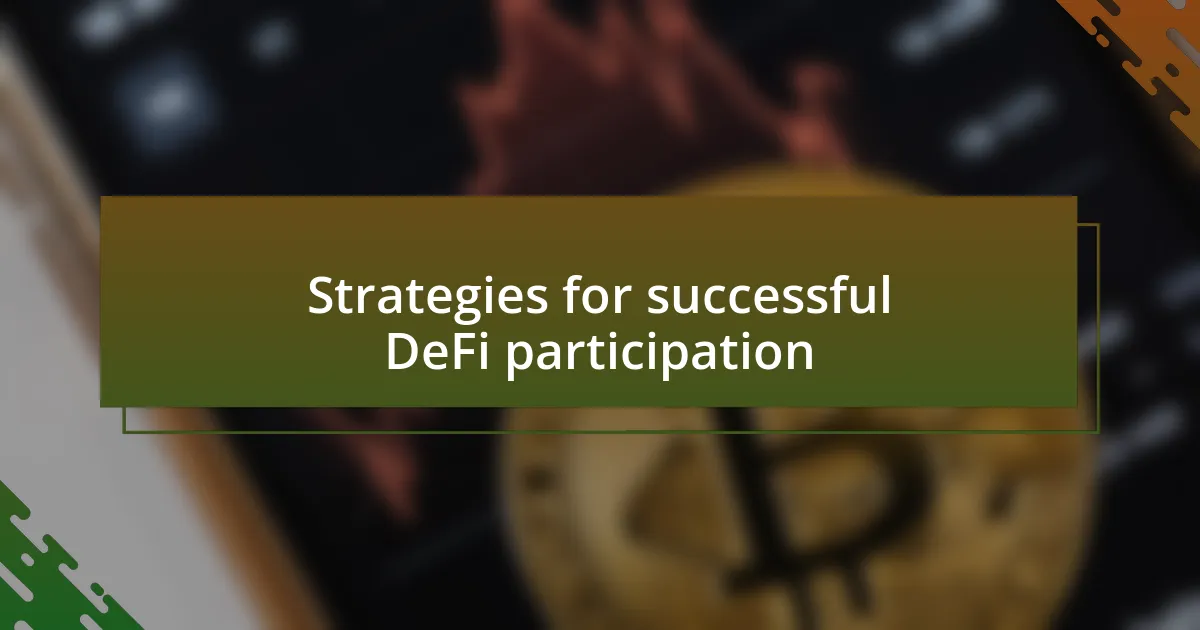
Strategies for successful DeFi participation
When participating in DeFi, thorough research is paramount. I remember when I first ventured into yield farming; I dove headfirst into a platform that promised high returns but failed to understand how their algorithm worked. It struck me like a lightning bolt—knowing the underlying mechanics of a project is essential to making informed decisions. Have you ever committed funds without fully grasping where they were going? It’s a lesson I won’t soon forget.
Diversification emerged as a critical strategy for me. Initially, I put all my investments into one promising DeFi token, only to watch its value plummet overnight. That experience taught me to spread my investments across multiple projects and sectors within DeFi, which helped mitigate risk. Isn’t it interesting how a little bit of variety can significantly cushion potential losses?
Engagement with the DeFi community offers invaluable insights. I joined forums and attended webinars which illuminated aspects of projects I hadn’t considered before. Sharing experiences and exchanging knowledge with others has not only bolstered my confidence but also helped me avoid pitfalls I might have otherwise stumbled into. Have you found similar value in community interactions? It’s often where the best lessons are learned.
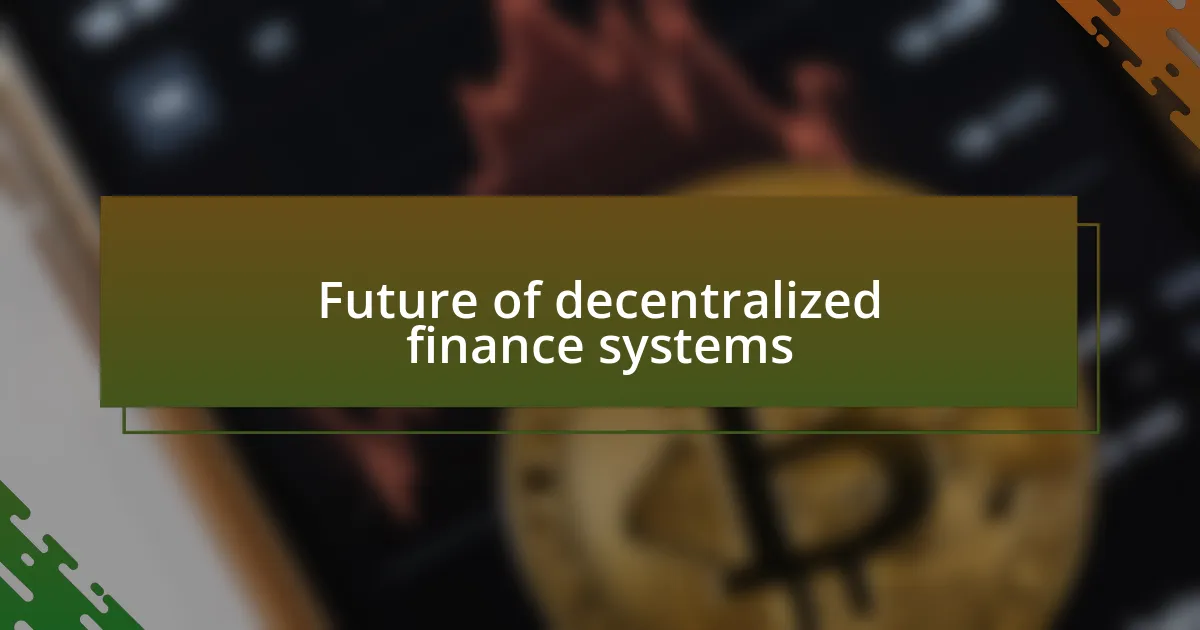
Future of decentralized finance systems
As I look into the future of decentralized finance systems, I can’t help but feel a sense of optimism. It’s fascinating to see how traditional financial institutions are starting to take notice of DeFi. Just the other day, I read about a major bank exploring partnerships with DeFi projects. It made me wonder: are we witnessing the beginning of an era where conventional finance and decentralized systems coexist?
One aspect that excites me about DeFi’s future is the potential for enhanced accessibility. Remember when I struggled to open a bank account due to stringent requirements? In contrast, DeFi platforms allow anyone with an internet connection to engage in financial services. This broadening of access can empower countless individuals globally. How transformative would it be if everyone had equal opportunities in personal finance?
Looking ahead, I envision innovations in security and user experience within DeFi. The recent hacks and scams have certainly been a reality check for many of us, including myself. It’s made me wary, but it also drives the community to prioritize security measures and better interfaces. I often ask myself: what will it take for DeFi to gain complete trust? Ultimately, a focus on safety and usability will be critical in fostering wider adoption, and that’s something we should all pay attention to.




